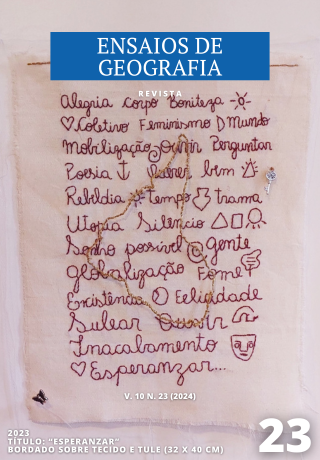v. 10 n. 23 (2024): Dossiê Formação Inicial e Contínua de Professores: oportunidades e desafios do cotidiano profissional

CAPA
“Esperanzar”, Bordado sobre tecido e tule, 32 x 40 cm – 2023
Bordar é compor gestualidades que expressam com linhas e tecidos modos de estarmos no e com o mundo. Com esses gestos instauro um tempo dentro do tempo das atividades cotidianas da docência para a composição de outras formas de exercícios de atenção com os objetos e desejos de expressão. Descobri o bordado no meio da escrita e da pesquisa da minha tese de doutoramento em educação entre os anos de 2014 e 2018. Naquela pesquisa, a cartografia escolar era tomada como um problema, e o encontro com a arte (e o bordado) foi uma possibilidade de abertura dos mapas oficiais às possibilidades de imaginação e sensibilidades outras. Em uma série de bordados, pela profanação das cartografias, a agulha e as linhas perfuraram o estático, o dado e o inquestionável modo de produção das representações espaciais. Pelo atravessamento das linhas nos tecidos foi possível ver um mundo também pelo seu avesso, assim como produzir cartografias que desterritorializam a ordem oficial dos mapas ao percorrer territórios fixados pela representação, reterritorializando a vida que teima em atravessar cartografias estáticas.
Além dessas questões, a investigação de artistas como Leonilson, Bispo do Rosário e Rosana Paulino, que usam o bordado como suporte em suas obras, foram imprescindíveis para aprofundar as técnicas de feitura, e também educar o olhar estético para esses trabalhos. Essa é, talvez, a parte mais bonita da docência: quando os caminhos das pesquisas nos levam a outros lugares, a costurar outras conexões estéticas e teóricas. Neste bordado “Esperanzar” (2023) o encontro teórico e estético se deu com dois intercessores: Paulo Freire e Joaquim Torres Garcia. Em Paulo Freire busquei palavras do dicionário organizado por Danilo Streck, Euclides Redin e Jaime José Zitkoski, publicado em 2008, utilizado em minhas aulas de Didática na UFPR. O livro A cidade sem nome, publicado em 1941 por Torres Garcia, foi a inspiração estética para o bordado, assim como sua outra obra América invertida, de 1943. No livro, assim como no mapa percebi um encontro com a gestualidade das mãos que o bordado também exige. Torres Garcia, ao publicar o livro fez questão de mantê-lo com a grafia manual, ao invés da tipografia, pois acreditava que esta era muito impessoal, e com isso nos apresenta uma simbiose perfeita entre desenhos e escrita.
A criação do bordado, com palavras e o mapa invertido de Torres Garcia, se deu a partir de um encontro com outra colega geógrafa e professora da Universidade de Buenos Aires, Claudia Pedone. Juntas pensamos a escrita sobre meus bordados cartográficos para a sessão “Geografia Y Arte” da revista Punto Sur (2023). A ideia era apresentar com a escrita as conexões entre alguns bordados e sua pesquisa sobre mulheres migrantes na América do Sul. Na época, Cláudia estava preocupada com os rumos que as eleições poderiam dar ao povo argentino. Entre conversas por telefone e trocas de áudio chegamos a Paulo Freire, e a palavra-verbo criada por ele: “Esperançar”. Para Freire, “esperançar é se levantar, esperançar é ir atrás, esperançar é construir, esperançar é não desistir”. Na medida em que o inevitável se consumava, apresentar essa palavra e bordá-la no tecido junto a outras palavras tão significativas foi uma forma de manifestar o [nosso] cuidado em linhas. Conversamos, principalmente sobre os sentidos da palavra “esperançar”, que sem uma tradução específica nos fez mais próximas a
construção de um sentido entre duas línguas: Esperanzar.
Essas sutilezas das artesianas feitas à mão compõe as qualidades expressivas, ou matérias de expressão da imagem-bordado. Essas matérias de expressão, talvez antecedam a própria composição do trabalho. Pois é incitada uma gestualidade para esse escrever-fazer à mão que passa pela escolha da disposição do desenho, dos tipos de texturas dos tecidos, das cores e espessura das linhas, do lugar da casa para se acomodar e iniciar o bordado... Gestualidades que passam pelas mãos, pela sutiliza em pegar as linhas e fazê-las passar pelo tecido de modo firme, dos volumes e texturas que esse atravessar de linhas confere ao tecido. Nesse escrever-fazer há um outro tempo organizado que não cabe no Lattes, nos programas de trabalho da universidade, ou nos tempos das aulas. São antes, linhas em errância à docência homogeneizadora. Perfurar o dado para ir ao encontro de outras forças. Atravessar as tramas do tecido, propor a espaços lisos da cartografia oficial volumes, texturas, cores e desejos de expressão. Seguir com a proposição de exercícios de atenção aos possíveis universos de pesquisa que o bordado abre na educação e na educação geográfica, na preparação para a docência e na construção para si de procedimentos inventivos em que aprender é o próprio processo provocador de deslocamentos.
Karina Rousseng Dal Pont
Professora do Departamento de Teoria e Prática de Ensino da Universidade Federal do Paraná (UFPR)
@kadalpont

